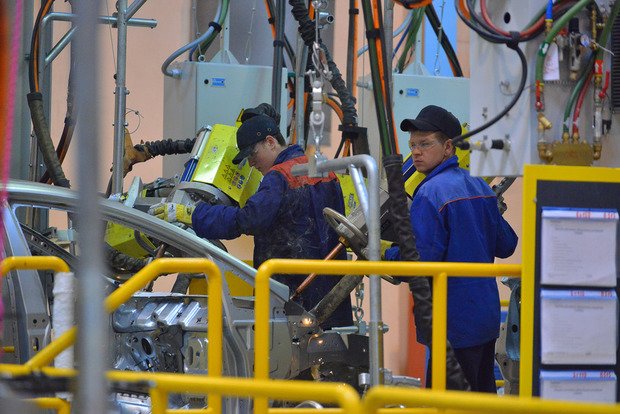''The risk of ruble depreciation to 80-90 per dollar is very high if oil prices fall by a quarter''
Experts have found weaknesses in the forecast of economic development of Russia until 2024
Experts of the Russian Presidential Academy of National Economy and Public Administration (RANEPA) and the Gaidar Institute criticized the forecast of the ministry of economic development of Russia for the next 6 years. They consider officials' assessments too optimistic. In the context of sanctions and counter-sanctions, Russia is going to close ''from the developed world'' more and more and its economy will continue to simplify. Besides, the expected drop in oil prices can lead to a weakening of the ruble to the level of 80-90 rubles per dollar. Read more in the material of Realnoe Vremya.
Two scenarios
Experts of RANEPA and the Gaidar Institute Aleksey Vedev, Sergey Drobyshevsky and Maria Kazakova have found weaknesses in the forecast of the ministry of economic development of the Russian Federation for 2019-2024, attached to the draft federal budget.
According to them, part of the macroeconomic forecast, which covers the years 2019-2020, is discreet and realistic. Another part — for the period from 2021 to 2024 — is aimed at achieving the goals of the new May Decree. On the other hand, they note, there are a number of controversial points in the officials' calculations.
The ministry presented its forecast in two versions — basic and conservative. The first assumes that in 2019 the economy will slow down to 1,3% (from 1,8% in 2018), but then, thanks to the implementation of national projects, pension reform and measures to increase investment activity, the growth will reach a higher trajectory and reach 3,3% in 2023.
The conservative version includes a scenario of a ''hard touchdown'' of China's economy (see reference), which in turn will lead to a slowdown in the global economy. In this case, a fall in energy prices is expected, as a result of which the dynamics of Russia's GDP will be weaker. According to the conservative forecast, the economy will grow by 1% in 2019, after which the pace will gradually increase to 3% in 2023.
Isolation and 90 rubles per dollar
Experts believe that the cautious forecast for economic growth and oil prices ''is absolutely justified''. At the same time, there are risks that certain parameters of the forecast may remain unachieved.
''The prospect of new sanctions from the US, the widely discussed response from Russia mean only an even greater closure of the economy from the developed world. This not only will not help to increase total factor productivity and the sustainability of economic growth, but will also lead to even greater simplification of the economy structure and the disappearance of the prospects of diversification of production and export,'' they report.
The authorities are planning to reach the growth rates laid down in the basic scenario at the expense of national projects — their implementation will stimulate the activity of private business and the growth of investments. However, this logic is doubtful, experts say: the ministry of economic development has not proposed specific mechanisms that would give business incentives to invest.
Until 2021, the Russian economy will increase the costs associated with the fact that the growth of real wages will significantly exceed the growth of labour productivity. It is unlikely to avoid this without a sharp reduction in wages.

Besides, the ministry ignores the impact of oil price shocks. In the basic forecast, the price of oil is gradually reduced to $53,5 per barrel by 2024 (in January-September 2018, the average price was $70,6). At the same time, the ruble exchange rate remains unchanged until 2023, not falling below 66,5 rubles per dollar. Only in 2024 officials expect weakening to 68 rubles per dollar. Meanwhile, the ruble was at this level this year when oil cost more than $70.
Experts give their own scenario on the ruble exchange rate. According to them, in the case of a drop in oil by 25%, as well as amid the preservation of sanctions and currency interventions by the Central Bank, the probability of ruble weakening to 80-90 rubles per dollar is very high.
Against the background of high inflation expectations and VAT increase, a weak ruble will contribute to rise in prices. The risks of accelerating inflation will prevent the Central Bank from moving to a neutral monetary policy until 2024. The key rate all this time will be by 3-4% higher than official inflation, restraining lending to companies. This, by the way, is another factor that plays against investment activity.
Not to repeat the mistakes of China
Valery Mironov, the deputy director of the HSE Development Centre, also believes that the minitry's forecast needs improvement. The authorities hope that the economic growth will be investment-oriented, so the forecast includes a sharp jump in investments from 2020. This jump does not look very natural, Mironov notes: usually investment activity occurs as a result of economic growth, but does not precede it.
 ''Apparently, they [officials] are aimed at investment increase through infrastructure projects. But to make infrastructure projects on such a huge territory, it is necessary to understand in which direction the production activity will develop. We don't know that yet. Where to build infrastructure? Maybe we will export goods to Europe, or increase supplies to China, or to Latin America, or settle long-term political problems with Japan.''
''Apparently, they [officials] are aimed at investment increase through infrastructure projects. But to make infrastructure projects on such a huge territory, it is necessary to understand in which direction the production activity will develop. We don't know that yet. Where to build infrastructure? Maybe we will export goods to Europe, or increase supplies to China, or to Latin America, or settle long-term political problems with Japan.''
According to Mironov, China had a sad experience of thoughtless construction of infrastructure: local authorities artificially accelerated investments to 45% of GDP, leaving ''empty, dead cities and highways''.
It should be noted that the International Monetary Fund assesses the prospects of the Russian economy more positively than the ministry of economic development of Russia. In October, it improved the forecast for Russia's GDP growth in 2019 to 1,8%.
Reference
Amid the trade war with the US, China's economy this year has shown the weakest growth since the global financial crisis of 2008-2009. In addition, the situation with China's ''secret'' debt has recently been revealed. According to S&P, the authorities of Chinese provinces and cities, as well as state-owned companies, have accumulated liabilities at $5,8 trillion, which were not reflected in the balance sheet of the state. According to experts, this may lead to the sale of Chinese assets by investors and threatens a new debt crisis.